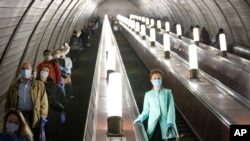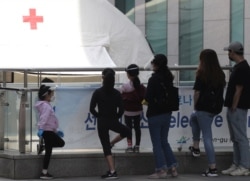Several countries have begun easing measures to contain the new coronavirus, despite confronting upsurges and warnings of a second outbreak.
India resumed some train service Tuesday for the first time since March, defying a surge that saw about 3,600 new cases Monday, just less than a record high number of new cases the day before.
The Russian government also started gradually lifting lockdown measures Tuesday as infections in the country exceeded 232,200, second only to the U.S. Russian construction and factory workers returned to their jobs Tuesday, despite the growing number of COVID-19 cases.
In the U.S., the world leader by far in infections and fatalities that have topped 80,000, the country's top epidemiologist, Anthony Fauci, warned at a Senate hearing Tuesday of "needless suffering and death" if people return to work and their normal routines before the pandemic has been contained.
Fauci's warning is in sharp contrast to U.S. President Donald Trump's effort to reopen the country as the unemployment rate has soared to levels not seen since the Great Depression.
The Trump administration said Monday about 9 million people have been tested and that the capacity for more tests is increasing. But infection rates are reaching new highs in several metropolitan areas and in smaller communities in the U.S., according to undisclosed White House coronavirus task force data that NBC News reported it obtained.
NBC News reported the information was in a May 7 report, which said the top 10 areas experienced surges of at least 72.4% over a seven-day period compared with the week before.
Quarantines in Spain
In an effort to try to prevent importing new cases of the coronavirus, Spain is requiring people arriving from abroad to go into quarantine for two weeks.
The country has started to emerge from a seven-week, strict lockdown after an explosion of cases made it one of the world's COVID-19 hot spots.
A health ministry order published Tuesday said the quarantine rules will go into effect on Friday and will apply both to visitors from other countries as well as Spanish citizens who are returning home.
People will be allowed only to go grocery shopping or to seek medical care during the 14-day period.
China instituted a similar strategy as it saw its locally transmitted cases sharply decline and authorities began easing lockdown restrictions. But Chinese authorities said they would test all 11 million people in the city of Wuhan, where the outbreak began, after new cases were reported there.
Governments around the world are currently weighing their strategies and whether it is time to impose new measures to stop the spread of the virus or allow people to resume parts of normal life.
In Singapore, Tuesday brought a new phase in reopening with people allowed to get a haircut, visit bakeries or go to laundromats.
Contact tracing
South Korean authorities are worried about a resurgence of cases and are working to track down people who recently visited nightclubs in Seoul where a cluster of new infections has emerged.
Officials said Tuesday teams are using phone and credit card data to try to track down about 2,000 more people so they can be tested. So far, there are more than 100 confirmed cases linked to nightclubs.
So-called contact tracing has been a major element as governments try to stop the spread of the coronavirus by finding who may have been close enough to someone who has tested positive. Those people can then be tested themselves, and isolated if necessary.
The World Health Organization is advising nations to ensure that the pandemic is under control before reopening. WHO's Director-General Tedros Adhanom Ghebreyesus said Monday that countries should also have surveillance systems in place to be able to detect and manage any resurgence of cases and ensure that their health systems can cope with a possible resurgence after reopening.
He also said there are about seven or eight of what he called top vaccine candidates among the many currently being developed around the world. He said that while several months ago experts expected the process of getting a vaccine ready for public use would take 12 to 18 months, there are efforts to accelerate that process with the support of $8 billion in pledges made last week.
Worldwide, the number of confirmed coronavirus cases is more than 4.2 million. The global death tally is nearly 290,000, according to Johns Hopkins University statistics.












